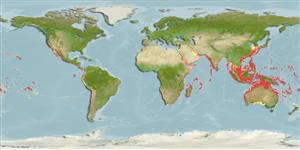Common names from other countries
Environment: milieu / climate zone / depth range / distribution range
экология
морской ассоциированный с рифами; пределы глубины 0 - 132 m (Ref. 58302). Tropical; 37°N - 38°S, 20°E - 70°W
Indo-Pacific: Red Sea and East Africa to Rapa and Easter Island, north to southern Japan, south to Australia and New Zealand (Ref. 5755). Eastern Central Pacific: Mexico to Panama, including offshore islands (Ref. 9301). First record in the Mediterranean was reported (Ref. 36327), and from several countries as of late year 2010. Often misidentified as Fistularia petimba, a reddish or brownish-orange deep-water species with bony plates along dorsal midline.
Length at first maturity / Size / Вес / Возраст
Maturity: Lm 65.0 range ? - ? cm
Max length : 160 cm TL самец/пол неопределен; (Ref. 9301); common length : 100.0 cm TL самец/пол неопределен; (Ref. 9301)
колючие лучи спинного плавника (общее число) : 0; членистые (мягкие) лучи спинного плавника (общее число) : 14 - 17; колючие лучи анального плавника: 0; членистые (мягкие) лучи анального плавника: 14 - 16; позвонки: 83 - 86. Vertically flattened rather than laterally compressed body. Long whiplike tail filament. Color is green dorsally, grading to silvery white ventrally, with two blue stripes or rows of blue spots on the back. Dorsal and anal fin orange becoming transparent at base. Caudal filament white. Broadly banded at night (Ref. 48635). First four vertebrae fused (Ref. 9826). Branchiostegal rays: 5 (Ref. 36710).
Adults inhabit reef habitats to a depth of at least 128 m, except in heavy surge areas. Also found in sandy bottoms adjacent to reef areas (Ref. 36710), either solitary or in schools (Ref. 9710). Benthopelagic (Ref. 58302). Feed on small fishes, shrimps (Ref. 36327, 36710) and squids (Ref. 37816). Probably marketed fresh, salted or dried or smoked but more often reduced to fish meal (Ref. 9301).
Myers, R.F., 1991. Micronesian reef fishes. Second Ed. Coral Graphics, Barrigada, Guam. 298 p. (Ref. 1602)
Статус Красного Списка МСОП (Ref. 130435)
CITES (Ref. 128078)
Not Evaluated
Угроза для людей
Reports of ciguatera poisoning (Ref. 130160)
Использование человеком
рыболовство: не имеет хозяйственного значения; аквариум: коммерческий
дополнительная информация
инструменты
Специальные отчеты
Скачать в формате XML
ресурсы в Интернет
Estimates based on models
Preferred temperature (Ref.
115969): 22 - 28.9, mean 27.5 (based on 1674 cells).
Phylogenetic diversity index (Ref.
82804): PD
50 = 0.6250 [Uniqueness, from 0.5 = low to 2.0 = high].
Bayesian length-weight: a=0.00129 (0.00092 - 0.00181), b=3.00 (2.91 - 3.09), in cm Total Length, based on LWR estimates for this species (Ref.
93245).
Trophic level (Ref.
69278): 4.3 ±0.7 se; based on diet studies.
устойчивость к внешним воздействиям (Ref.
120179): высокий, минимальное время удвоения популяции до 15 месяцев (Preliminary K or Fecundity.).
Fishing Vulnerability (Ref.
59153): Moderate vulnerability (42 of 100).
